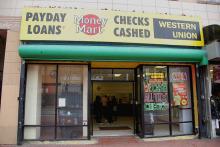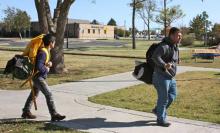economic injustice

BY NOW, MOST of us have been affected by problems with the “supply chain.” It started last year with shelves void of toilet paper, then morphed into a lack of other manufactured goods, including construction materials, cars, and medical equipment.
Other than this being a (sometimes serious) nuisance, why should people of faith take notice? From our perspectives—as a theologian and a developer of worker-owned cooperatives—the broken supply chain throws light on some of our deepest economic and political problems.
The current shortage of goods and services is often attributed to the COVID-19 pandemic. Its roots, however, are in an economic system designed to produce maximum profits for the few rather than the many by outsourcing production. The “few” are called shareholders and the “many” are those who work for a living. While many working people also own some shares, the bulk of profit in this system goes to those with the largest portfolios and majority positions. No wonder U.S. billionaires have gained more than $2 trillion since the pandemic began.

WEST VIRGINIA’S schoolteachers went on strike on Feb. 22. Although West Virginia has a proud labor history, the state’s two teacher unions (West Virginia Education Association and American Federation of Teachers-West Virginia) do not have the right to strike. After decades of labor movements failing nationally, the Trump age has not seemed like a prime moment for a revival. And West Virginia’s government is firmly in the hands of Republicans.
Fast-forward to March 7. Schools reopened after a statewide strike that lasted two weeks. Teachers procured a 5 percent raise, not only for themselves but for all state employees, from state police to highway maintenance workers to clerks at the DMV.
When schools reopened, the Charleston Gazette-Mail interviewed a woman dropping off her grandchildren at Horace Mann Middle School. She said the children wanted to support their teachers, who every day stood in the cold outside their school. “Every time we’d pass by the teachers [picketing] outside, they’d say, ‘Blow it, Nana. Blow the horn.’”

BY MOST MEASURES, the day had been a success. On the morning of Dec. 4, 2017, nearly 300 people crammed into a small room near Washington, D.C.’s Capitol Hill to reignite the 1968 Poor People’s Campaign. Camera crews filmed while clergy, Indigenous leaders, Fight for $15, Iraq Veterans Against the War, and state groups from around the country pledged their support.
From there the leaders marched to the U.S. Capitol to deliver a letter condemning the then-looming tax bill. “Woe to those who make unjust laws,” they read from Isaiah 10, “to deprive the poor of their rights.”
Later, the same crowd—plus locals lured by a lineup featuring Sweet Honey in the Rock, Maxwell, and Van Jones—gathered at D.C.’s Howard Theater to celebrate. Faith leaders and activists who’d linked arms together in places such as Flint, Mich., Charleston, S.C., and Standing Rock in the Dakotas sipped drinks and ate free ice cream provided by Ben and Jerry’s. The overall vibe was part social-justice pep rally, part family reunion.
But Rev. William Barber II wasn’t feeling it.
While the DJ played ’80s hip-hop, Barber lumbered onto the stage unannounced. He didn’t have a microphone, so he just started yelling. The perplexed stage crew scrambled to find a working mic, but Barber was impatient. The DJ cut the music and the theater grew quiet.
“My brothers and sisters,” boomed Barber once he had a mic. “This is a Poor People’s Campaign mass meeting and concert; this is not a party.”
‘Make this nation cry’
For the next 10 minutes, Barber worked his way through the litany of injustices that he and Rev. Liz Theoharis, co-chairs of the campaign, had repeated from countless pulpits over the past year as they crisscrossed the country recruiting people for the Poor People’s Campaign: deaths caused by lack of health insurance, the rollback of voting rights, corporate drilling on Native American lands, homelessness, police violence, an unlivable minimum wage, Flint’s inability to provide its citizens with clean water, political corruption. He spoke without notes, rambling at times (“I don’t have time to be scripted because the evil that’s happening is not scripted”), but it didn’t matter; as he neared the end of his list, the mood of the room had grown somber.

IT IS EASY to feel overwhelmed or paralyzed by the systemic nature of how money and development works, or—if you are a gentrifier yourself—to feel guilty to the point of inaction. While each neighborhood and context may differ, individual Christians and congregations can live into beliefs and practices that help address the crisis of mass displacement in the U.S.
1. Be Your Neighbor’s Keeper
Pastor Mark Strong believes the best thing Christians in a gentrifying city can do is to hear and understand the stories of their neighbors. In Portland, he says, most of the African-American churches have suffered in silence. White Christians have not been aware of the crisis taking place next door to them. Intentional relationships and active listening can begin to remedy this.
Finding and investing in ongoing relationships with people most at risk of displacement is vital. There are myriad ways to do this: living in lower income apartments, investing in the public schools, seeking out community organizers and grassroots nonprofits—and learning from local churches with long-term roots in the community.
2. Know the Plan
Tim Keller advises people moving into a neighborhood at risk of gentrifying to see if a plan is in place to minimize displacement, and if not, to ask how one could be created. This plan—put together by the local government, nonprofit agencies, developers, and businesses, along with churches and community leaders—is vital to understanding both the issues specific to the neighborhood and ways to hold all accountable. Without a plan in place to shield properties and families from the market, middle-class and wealthier individuals will be directly contributing to gentrification.

After winning the Triple Crown, American Pharoah’s jockey, Victor Espinoza, showed that he doesn’t live in fear of losing his power. And, as opposed to the Egyptian Pharaoh, he showed he has a soft heart for those who are suffering.
Espinoza reportedly earned $80,000 for his victory at the Belmont Stakes and he’s giving it all away. “I won the Triple Crown right now,” he stated, “but I don’t make any money because I’m donating all the money to the City of Hope.” The City of Hope is a cancer research and treatment center. Espinoza also donates his time at the City of Hope, visiting with children struck by cancer. He says, “The kids [are] 6 years old, 10 years old, it’s just heartbreaking.” Why does he do it? “I just saw one kid with the disease and that’s how I changed my life. I changed the way I think. Pretty much I changed everything … the first change I made was in my heart.”

I love Martin Luther King. I wrote my master’s thesis on his approach to nonviolence. King is the greatest prophet in the history of the United States. And white people should know him better.
Blitzer, like so many white people, doesn’t know Martin Luther King. He misses King’s point. If white people want to reference King, we need to stop using him to condemn black violence. We need to stop pitting a black man against black people. It’s patronizing. It’s demeaning. And it misses the point.

Editor's Note: This is the final piece in a three-part series on Financing Seminary Education. Read Part 1 here and Part 2 here.
“The higher education industry is facing a multi-pronged and existential threat composed of successive waves of disruptive innovation” (Butler, “Tottering Ivory Towers,” American Interest (Sept/Oct). It seems higher education, including seminary education, is going the way of the music and media industries! Our 2,000-year-old business model of “sage on stage” could be truly doomed. The appearance of “massive open online courses” (MOOCs) over the past few years has thrown many higher education institutions for a loop, and more innovations are on the way.
In response to these new innovations higher-ed institutions, including seminaries, have tweaked their business models with a few technological modifications such as PowerPoint, email, electronic research, and online courses. But, will it be enough? Butler says “no” and so do the trends. The reality is graduates of today’s higher-ed institutions are not evidencing the competencies expected and/or hoped for by their future employers. Consequently, accreditation standards, at an all-time high in complexity, are now beginning to be challenged. Simultaneously, tuitions are costly, the economy is tough, and the job market is even tougher. The end result is that students are graduating with large amounts of student loan debt and potential students are opting out of the education market.
We began the 21st century with denominations and churches that no longer fit the needs of a shifting society, a Congress that votes against the poor and the middle class, and seminaries that face multi-pronged threats to their existence. It’s time for an overhaul!

The United States hosts more than 23,000 payday lending stores, which outnumbers the combined total of McDonald’s, Burger King, Sears, J.C. Penney, and Target stores. These payday lenders do not make conventional loans as seen in most banks, but instead offer short-term loan amounts for short periods of time, usually until the borrower’s next paycheck, hence the name “payday loans.”
While some borrowers benefit from this otherwise unavailable source of short-term and small-amount credit, the payday lending business model fosters harmful serial borrowing and the allowable interest rates drain assets from financially pressured people. For example, in Minnesota the average payday loan size is approximately $380, and the total cost of borrowing this amount for two weeks computes to an appalling 273 percent annual percentage rate (APR). The Minnesota Commerce Department reveals that the typical payday loan borrower takes an average of 10 loans per year, and is in debt for 20 weeks or more at triple-digit APRs. As a result, for a $380 loan, that translates to $397.90 in charges, plus the amount of the principal, which is nearly $800 in total charges.

Last weekend, I had the opportunity to spend the night at the Metropolitan House Men’s Shelter, part of Washington, D.C.’s, Metropolitan Memorial United Methodist Church.
And in this experience, Henri Nouwen’s, In the Name of Jesus came to life for me. In reflecting on his own experience of transitioning from Harvard University to L’Arche, a house for mentally disabled individuals, Nouwen realized he had to rediscover his true identity. Up until that moment, Nouwen relied on his accomplishments, achievements, accolades, educational training, and social connections to legitimize his impact and reputation in ministry as a priest. However, at L’Arche none of the things he relied on seemed to matter, and he had to gain credibility with those he planned to serve — the mentally disabled. Nouwen states, “I was suddenly faced with my naked self, open for affirmations and rejections, hugs and punches, smiles and tears, all dependent simply on how I was perceived at the moment” (28). Nouwen was forced to let go of his “relevant” self. Nouwen defines relevant self as, “the self that can do things, show things, prove things, build things.” Nouwen would have to allow himself to become vulnerable while suppressing his “relevant” self.

Caleb is a father in Africa. He works hard as a night watchman, and he and his wife save from their small income with the dream of sending their daughter to college. But the family’s dreams are destroyed when the police arrest Caleb on a random sweep for a robbery he had nothing to do with. This is not to say that the evidence against him was flimsy; there is no evidence against him whatsoever. The police needed to show an arrest had been made, and Caleb was an easy target … because he was poor.
Once in police custody, Caleb is viciously beaten. He is shaken down for bribes. And then, he is thrown in jail and charged with a capital offense. He is given no indication of when he might have a chance to prove his innocence – and even if he were, Caleb can’t afford a lawyer to help him. His family struggles to hang on without him.
What is perhaps most stunning about Caleb’s story is not the brutality (though it certainly is brutal), the singular unfairness of it all (though it is dramatically and utterly unjust), the hopelessness (though the story is obviously devastating). No, what is most stunning is just how ordinary Caleb’s story is.

If the outcome of Sunday’s Super Bowl comes down to the game’s final play, and you find yourself inclined to ask Jesus to help your favorite team win, remember: It’s quite possible he doesn’t know squat about tackle football.
At least, when we read the opening sentences of his Sermon on the Mount (found in Matthew 5:1-12), it seems his values are light years away from the confident and muscular ethos that football teams rely on for success. He directs attention in this passage toward the weak, powerless, and vulnerable elements of humanity. Consider these some of the groups he embraces:
- The poor in spirit : referring either to humble people or to those who are broken and have lost hope.
- Those who mourn : those who suffer loss and the feeling of emptiness that follows.
- The meek : those who are gentle and unobtrusive, who refuse to use power over others as a tool to make things happen.
- The merciful : people who willingly surrender their privileges or otherwise go out of their way to improve others’ well being.
- Those who are persecuted : people whose refusal to give up their quest for truth or virtuousness results in the taking away of their rights, wholeness, or dignity.
Careful, Jesus, or you’ll get blamed for contributing to the wussification of America .
The kinds of people Jesus highlights tend to dwell beneath society’s radar. They often stay out, or are kept out, of public view. They possess little power. Most of us can find no good reason for aspiring to join these groups.
Eye-opening numbers about the Super Bowl … and how they stack up against other things going on in America.

There’s an absurd character in The Little Prince by Antoine de Saint-Exupéry who reveals more about our capacity for self-delusion than we might want to admit. He’s called the King and when it comes to desire, he is as deluded about his own power as we are about ours. The King’s delusion is this: he believes that the movements of the sun, moon, and stars are the result of his commands. That’s right – the sun rises and sets because the King commands it to be so. Our delusion is nearly identical: we believe that we are the source of our desires, that they arise and fall at our command. Because of our shared delusions, we and the King are quite out of touch with reality. Remarkably, the cure for us is also the same – spending some quality time with the Little Prince.

Many of us may not know what it is like to be hungry, to regularly miss meals, or to consume a diet void of essential nutrients to live a healthy life. Poet, diplomat, and politician Pablo Neruda captures this feeling well in his poem “The Great Tablecloth.” Just before the holidays, millions of Americans learned what some aspect of hunger felt like as they saw a reduction in their SNAP (formerly food stamp) benefits.
On Nov. 1, every SNAP household saw its grocery budget reduced when an $11 billion cut went into effect — the equivalent of 10 million food stamp meals a day. And the program isn’t out of the woods yet. The House and Senate have begun to finalize a farm bill that will impact vital anti-hunger programs. A compromise proposal expected in the coming weeks could further cut SNAP by as much as $8 billion, at a time when lawmakers need to protect and strengthen it.

For Catholics—and many others—what happens in Rome doesn’t stay in Rome. The seating of a new pope has the power to affect believers across the globe, in ways direct, indirect, and unpredictable. And when a surprising sea change occurs in a hide-bound, steeped-in-tradition place like the Vatican—the unexpected resignation of a pope, the selection of a Jesuit from the Americas as his replacement, and the powerful symbolism of a new leader who literally stoops to wash a Muslim woman’s feet—people of faith of all traditions sit up and take notice.
In these early days of Francis’ papacy, we asked three prominent Catholic thinkers and leaders to help us understand what it all might mean. How will the spirit of reform that has marked Pope Francis’ first few months in office affect the worldwide church? Will change at the top trickle down to parishes and neighborhoods here in the United States and elsewhere? And what will Francis’ leadership mean not only for Catholics, but for all people of faith engaged in the work of making justice and building peace? —The Editors
CATHOLICS AROUND THE WORLD are transfixed by Pope Francis. We love his simplicity of life, his humble faith, his welcoming attitude to all, and his way of being Christian in the contemporary world that takes its bearings from the poor. Lace and gilt are no longer fashion statements at the Vatican. From his small apartment, the pope speaks bluntly about worrying less about rules and more about love. An utterly refreshing breeze blows through the Catholic Church.
But what does it really mean for Catholics today? The church still reels with the moral and spiritual damage done by members of the clergy as perpetrators or accomplices in the sex abuse scandals, from fiscal mismanagement, and from institutional infighting. Does Pope Francis change that? And what does the new pope signify for the young, for women, and for the many issues that vex the church’s engagement in today’s world?

Recent studies from both the Urban Institute and the Pew Forum tell the story of America's growing racial wealth gap. In the May issue of Sojourners magazine, Otis Moss III talked about the unjust trend:
The call of the church has been, and always will be, to become the compassionate hands and feet of Christ. Poverty, when attached to race, is the original sin of America, a country built by slave labor and enriched by the unfair labor practices of the Industrial Revolution.
Read the full piece HERE.

See the full infographic at the jump.

What comes into your mind when you hear the word apocalypse? Most of us think of us think of the total destruction of the world, or at least life as we know it. Think zombies roaming the streets, feasting on brains. On the other hand, my sarcastic generation is doing a pretty good job of using apocalypse as a silly word. I remember a few years ago when we had a large winter storm here in Washington, D.C.; it was instantly dubbed Snowpocalypse!
The English word apocalypse derives from the ancient Greek apocalupsis, which is the original title for the infamous Book of Revelation. Revelation involves a lot of fire, smoke, battles, and things generally blowing up, so it’s understandable that today we would associate apocalypse with end-times battles. However, the word apocalypse contains a much deeper meaning. Far more profound than the long-awaited zombie hordes – or even the end-times prophecies of some churchgoers – this ancient, misunderstood word is an essential tool for comprehending the world we live in.
Apocalupsis is a term that means unveiling – as in setting aside a covering to discover what lies underneath. At the most basic level, the Book of Revelation is about removing the blindfold that the Powers have pulled over our eyes, allowing us to see the world as it really is. Revelation is about unveiling Empire, exposing the ways in which powerful interests destroy the earth and enslave other human beings to promote their own luxury and power. Despite its reputation, Revelation is not about a future-oriented, earth-hating vision of universal destruction. On the contrary, it is a vision of a new creation and universal restoration – the world finally set right and edenic harmony restored in the midst of the city.
OK – great, you may be saying. Nice to know, but how is this relevant to me?
Fair question. It’s true that the Book of Revelation was written almost 2,000 years ago. Those were the days of the Roman Empire – think Ben Hur and Spartacus. For sure, things have changed a lot since then.
Yet, the more things change, the more they stay the same.

The announcement was broadcast at the end of the day over the school’s public address system.
"Our Teacher of the Year for 2013-2014 is ... Mr. Barton. Congratulations!"
I walked out into the third-grade hallway where students were lined up for dismissal. Little hands reached up and patted me on the shoulder. Small voices joined together and called out, "We're proud of you, Mr. Barton!" Alondra, a quiet student, pulled me close and said, "Thank you for being my reading teacher." I was honored and humbled.
As I walked back into my classroom, I reflected over my five years teaching at this Title I elementary school. "Who am I, what have I done, to become Teacher of the Year?" I asked myself.

I received a galimoto for Christmas. In case you didn't know, a galimoto is a toy vehicle created out of sticks, cornstalks, wire or anything children can take into their hands and make into a thing with wheels. Mine is a bicycle made of wire. There is a wire child in colorful cloth on the bicycle seat, a rider whose legs pedal as the wheels move. It is beautiful in its simplicity, astonishing in its complexity. It came from the hands of a child in Kenya. I love it.
I brought my galimoto to school and introduced it to my third-grade students. They held it in their hands, marveled at its design, and pushed it around the classroom. "A kid made this?" Matthew asked. "Amazing!"
We looked at a globe and located South Carolina and Kenya. We flew with our fingers from Greenville across the Atlantic Ocean across Africa to Nairobi. We wondered what it would be like to live there. What would the weather be like? What foods would we eat? What kind of house would we live in? What clothes would we wear? What would our school be like? What would our parents do? What would we play with? "I know what we would play with," said Syleana with a smile. "A galimoto!"
We took a picture walk through the book Galimoto written by Karen Lynn Williams and illustrated by Catherine Stock. "What do you notice when you look at the cover of the book?" I asked.
"It looks like the little boy is poor," answered Zaniya.
"Why do you think he's poor?" I continued.

When asked to identify common features of the historical Christmas storyline, many speak of Mary, Joseph, shepherds, wise men, angels, King Herod, and of course, the newborn Jesus. But we too often fail to recognize the social circumstances in which Jesus was born; our understanding of the nativity narrative is too often left incomplete.
In the midst of our various congregational and community Christmas celebrations, we are confronted with the harsh reality that Jesus was brought into the world within a condition of homelessness. As a result, one can argue that we cannot fully commemorate Christmas without recognizing its social setting, for the context of Jesus’ birth points us toward the content and concerns of Jesus’ life.

NORMAN, Okla. — Pastor Dustin Buff traded in his job, his house and his sense of security for a backpack, a Bible, a sleeping bag, one change of clothes, identification, and a cell phone.
For 10 days, Buff and youth minister Philip Nguyen were intentionally homeless, wandering the streets of Norman in a personal quest to understand the plight of the homeless.
Andrews Park, a mile and a half from the University of Oklahoma, is a temporary home to many of the city's homeless. Buff estimates 300 people live on the street in this city of 113,000. In the park, the homeless gather in gazebos, sleep in faux forts on the playground, and lounge on the steps of the amphitheater.
Buff pointed to the municipal buildings that ring Andrews Park.
“All the city offices are right there,” he said. “Homeless people are sleeping here at night right across the street from the police station. I’ve read government estimates that Norman has 1,700 homeless residents, if you include transient housing, shelters, and the streets.”